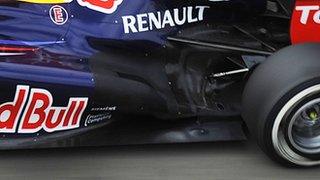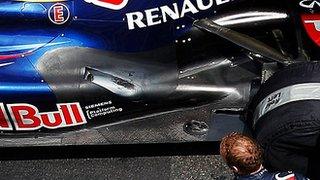Red Bull's lastest upgrades could make the difference in Valencia
- Published

Sebastian Vettel at Valencia
Red Bull have dominated the European Grand Prix at Valencia for the last two years and a strong showing in practice on Friday suggests they will be potential winners again this year.
Their performance at Valencia in 2010, external and 2011, external owed a lot to the Red Bull's rear-end stability, which was due to the downforce-boosting exhaust-blown diffuser technology that they pioneered and exploited better than anyone else.

The RB8's rear-end slot now connects up to the rear diffuser, managing the airflow better
That has been banned for this year, but teams are still trying to harness exhaust gases for aerodynamic effect and Red Bull have made some pretty significant changes to their car for Valencia this weekend in this area.
Since the start of the season, Red Bull have had a slot or duct in the rear floor, just ahead of the rear tyre. They have been playing around with it, and blocking it off for some races.

The rear sidepod is also much lower, compared with the Monaco spec of the car seen here
That is back for this race but in a different format - it now connects up to the diffuser, managing the airflow better in and around the leading edge of the rear tyre, sucking it into the low-pressure area in the diffuser and creating downforce.
Another big change is forward of that, in the rear sidepod design. It looks as if someone has sat on it - the top has been squashed down so it is much lower.
An important part of the modification is the hot air from the radiator - instead of exiting at the front of the rear tyre, it now comes out half way along.
That creates a sort of duct - which is good because you don't want that slow, hot air interfering with the fast, low-pressure air that creates downforce between the rear wheels.
These are pretty significant changes in how the team are trying to get the diffuser underneath the back of the car and the 'Coke-bottle' shape between the rear wheels above it talking to each other.
It's effectively trying to emulate the effect of the exhaust-blown diffuser, although it won't be nearly as powerful as that was.
That's not all - they also have a different rear wing endplate, little turning vanes on top of the sidepods like McLaren introduced a few races ago.
You'd have to say from watching practice that the changes are working well - Sebastian Vettel and Mark Webber were second and third fastest and the car looked strong out on the track.
There is a long way to go yet but if I had to say which team looked most in control at the moment, I would say it was Red Bull.
Good rear-end stability is really important at Valencia. There are a lot of braking zones from high speed into slow corners, and the drivers have to brake as they're turning into the corner.
If you have good stability, you can run the correct brake balance. If you haven't, you end up moving the brake balance further forward than is ideal to stop the rears locking up.
That's fine when you can brake hard and transfer a lot of weight on to the front. But as the tyres wear out, that becomes increasingly difficult. You can't transfer as much weight, so you tend to lock the front tyres more.
Lotus are another team fancied to do well in Valencia because their car has been good in higher temperatures so far, as a result of being easy on the tyres.
They have a number of front wing developments in Valencia - they probably have four different front wing configurations, from different flaps to endplates and so on. And one that is a combination of them all.
Ferrari have obviously made the most progress of the top teams since the start of the season. They have said they have some developments but I have to admit I have not seen them yet. They must be small, detailed changes.
McLaren have not got anything new here - they say their next big change will be in Silverstone in two weeks' time.
But I wonder how much of that is down to Jenson Button's struggles in recent races. It throws a bit of confusion into the mix when one of your drivers is doing a reasonably good job and the other guy is having a bit of a tug.
It means you just don't have that focus and direction, and it looks like McLaren have had a bit of a stall as a result of that.
Gary Anderson is the BBC's F1 technical analyst. He is the former technical director of the Jordan, Stewart and Jaguar F1 teams. He was talking to BBC Sport's Andrew Benson
- Attribution
- Published20 June 2012